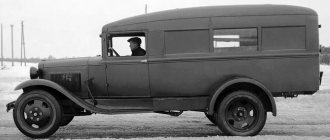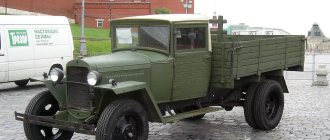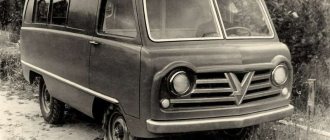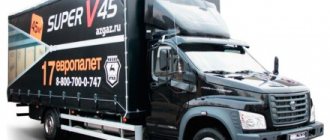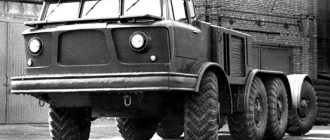GAZ-AA is a truck of the Nizhny Novgorod (1932) and later automobile plant in the city of Gorky, with a load capacity of 1,500 kg. The model is also called “lorry”. The debut 5-year plan for improving the economy of the Union of Soviet Socialist Republics (1928-1932) made it possible to begin a majestic development program.
The plan provided for the construction of more than 1,500 massive objects, including hydroelectric power plants, metallurgical plants, automobile and tractor factories. To implement all these projects, transport was needed, therefore there was a difficult strategic task - to organize a full-scale production of trucks. The entire GAZ model range.
Car history
By the end of the 1920s, truck series vehicles in the Union were mass-produced by only a couple of automobile enterprises: the First State Automobile Plant in Moscow (formerly AMO), as well as the Third State Automobile Plant in Yaroslavl. But their speed was not enough, since all two plants were created on the platform of pre-revolutionary capacities.
For example, by the beginning of the first five-year plan there were only 1,500 cars in the entire country. Therefore, no one was surprised that by the mid-1920s, the Soviet government planned to build the first automobile giant in the Union, the capacity of which would allow the production of about 100,000 vehicles per year.
When the necessary experience and technological resources were lacking, the best option was to buy production abroad. And the opinions of Russian experts were focused on an overseas country, or rather, Detroit.
This settlement, located in the north of America, was for the builders of socialism an exemplary automobile grandee, a city of the future in which settlers live and work, obeying a single and common functional plan. It was precisely in a similar format that the Russian automobile giant dreamed of constructing it.
They wanted to build residential areas for workers near the workshops and design all the accompanying infrastructure. As a result of the negotiations, ]General Motors[/anchor] decided to refuse involvement in the project, so the only variation remained ]Ford[/anchor]. This option suited the USSR quite well.
The very name of Henry Ford, along with his automobile empire, was often associated with technological solutions and rationalism. In addition, this company was known quite well in the Union of Soviet Socialist Republics, because, although not huge, but still stable purchases of Ford cars had been made since 1909.
On top of everything, the cars of the new Ford base, which in 1927-1928 replaced the previous generation “T”, were best suited for the needs of our country. The Ford-A passenger car and the Ford-AA semi-truck were simple, unpretentious, inexpensive and, very importantly, were well unified among themselves in terms of design.
According to the technical agreement, the USSR signed an agreement with Ford on May 31, 1929. They planned to build a car city not far from Nizhny Novgorod, near the village of Monastyrka, where there was a confluence of navigable rivers (Oka and Volga). The Union of Soviet Socialist Republics signed an agreement to build the enterprise along with a camp for those working there with the Austin Company in Cleveland.
The USSR began to cooperate with the famous American company Ford. As a result, a one and a half ton GAZ-AA truck, which was similar to the American, saw the light of day.
In addition to the construction of the automobile giant, the agreement with Ford provided for the operational construction of a pair of automobile assembly plants that would be located in Nizhny Novgorod and Moscow. They planned to assemble Ford cars from ready-made vehicle kits, because according to the contract, the Union of Soviet Socialist Republics was supposed to buy 72,000 vehicle kits.
These assembly shops provided the opportunity to start the production of cars even before the end of the construction of the enterprise in Nizhny Novgorod and were such plants for training production for those who worked there. To build and equip the branches, the American company decided to attract the already popular construction company Albert Kahn, Inc. in Russia.
Already at the onset of 1929, it was decided to allocate a share of the area of the enterprise of vehicles for agriculture “Gudok Oktyabrya”, which were located in the city of Kanavin, for the construction of the first automobile assembly plant. Already in the winter of the next year (1930), the debut Ford-AA trucks began to be assembled there from vehicle kits in America.
By the end of the same year, passenger cars, along with Ford trucks, began to be produced from the primary assembly line of an automobile enterprise in Moscow. But Nizhny Novgorod’s desires for an automobile town began to gradually melt away.
In part, this was due to the small project estimate, as well as due to the labor enthusiasm of the producers, which in an interesting way was able to harmonize with the negligence and lack of agreement in the decisions and work of many management bodies.
They were able to build the largest automobile enterprise in European countries at the right time, but the result was far from the “airy” dreams of an industrial town of the future. The new building near Monastyrka was popularly nicknamed Sotsgorod, and after 2 years it acquired the official status of the Avtozavodsky district of Nizhny Novgorod.
While the second half of the first month of 1932 was underway, at the enterprise prepared for the start of its designed capacity, they were able to master the production of the cylinder block, along with the crankshaft, frame side members and other other parts. Due to the lack of consistent supplies of components from suppliers (more precisely, sheet steel), the cabins of “pre-production” vehicles began to be assembled using plywood.
On January 29 of the same year, the debut NAZ-AA vehicles were released from the assembly line of the enterprise in Nizhny Novgorod. In October (7th) Nizhny Novgorod was renamed Gorky, therefore the name of the car was changed. At the end of 1932, the production of cargo vehicles at the Gorky Automobile Plant was about 60 vehicles every day. The name of the truck became GAZ-AA.
The GAZ AA car turned out to be reliable and durable, and lost, perhaps, to one real rival in the USSR car market - the Moscow three-ton ZIS-5. However, the automobile enterprise in Gorky had much more production capacity than ZIS.
Therefore, the lorry was supposed to become a “multifunctional soldier” of the national economy, and Gorky specialists designed various “civilian” and “military” vehicles and improved existing standard vehicles.
In order to test the weak structural points of the gas AA lorry truck, at the end of 1932, trucks took part in a test run from Nizhny Novgorod to Moscow and back. Six months later (in 1933) they took part in the summer extreme “Karakum” run.
The lion's share of standard breakdowns was explained by the low quality of components supplied by subcontractors. While 1933 was going on, automobile factories in Moscow and Gorky fully used the arsenal of vehicle kits from America and migrated to creating cars from spare parts of their production.
Within 3 years, the Gorky Automobile Plant was able to master the production of the brand new GAZ-M power unit (50 horsepower), which was a forced version of the GAZ-A engine. One and a half ton boats began to be equipped with the latest engine in 1938.
At the same time, a brand new steering device, synchronized with the Emka, was released, along with strengthening the fastening of the springs installed at the rear. A similar modification acquired the name GAZ-MM. The Gorky Automobile Plant assembled the last lorry on October 10, 1949.
The Ulyanovsk Automobile Plant, which had been assembling MM since 1947, stopped assembling these models only by 1951. From 1932, before the start of hostilities, the KIM enterprise, together with the car assembly plant in Rostov-on-Don, produced more than 800,000 1.5-ton “AA” and “MM” trucks. During the war, GAZ produced 102,300 cargo vehicles.
Model update
In the fall of 1942, the plant again returned to designing and testing new types of machines under the old designations. The efforts of the design team were focused on creating primarily military types: the all-wheel drive GAZ-63 (4x4) and its three-axle version GAZ-33 (6x6). People started talking about the GAZ-51 car as a new 2.5-ton truck in March 1943, when a meeting of automobile plant designers was held at the NKSM, at which GAZ developers reported on the results of tests of experimental models of GAZ-63 and GAZ-33 and a comparative analysis 23 models of American, British and German trucks.
The design council, based on test data from two models, decided that:
– a cross-country truck with a load capacity of 1.5–2 tons should be left with two axles. The three-axle design in this class does not provide a significant improvement in cross-country ability, since the third axle unnecessarily complicates and makes the car heavier (this is how the GAZ-33 model was produced);
– for better use of the truck base, the cab and engine should be moved forward as much as possible, while maintaining the possibility of servicing the engine from the outside.
At the meeting, a program was approved for assembling prototypes of the GAZ-51 and creating a base for serial production of these cars. By that time, it turned out to be possible to increase the load capacity of the GAZ-51 from 2 to 2.5 tons by slightly strengthening individual units and using tires with dimensions 7.50-20”.
Work on the GAZ-51 car project never stopped for a minute. Throughout the war, both experimental vehicles of the 1939 model were tested. The mileage of each copy reached 50,000 kilometers by 1944. One of the two vehicles had a gas generator installed. After the production of the GAZ-63 with a cabin from the American Studebaker US-6, at the turn of 1943–1944, construction of the third model of the GAZ-51 car began. The concept of the vehicle was formulated very clearly and clearly: a simple and reliable universal truck, assembled from the best units of that time, well developed and tested by world practice, some of which had already been put into production.
By slightly strengthening some units and using tires measuring 7.50-20”, it was possible to turn the GAZ-51 into a 2.5-ton vehicle, adding 500 kg of payload. The machine now has a hydraulic brake drive that has proven itself well in world practice. Gasoline consumption decreased by 30% compared to GAZ-AA. On the basis of the “fifty-first”, a family of vehicles was re-developed: a carriage-type bus with 25 seats, a bonnet bus (both on an extended chassis); 4-ton truck tractor, low-bed tractor based on GAZ-63. They decided to hold off on the gas-generating car; a number of technical problems in this area were still not resolved. Almost everything about this family remains on paper...
There is a legend that it was Stalin who gave the order to make the car 2.5 tons, but this is not confirmed by any memoirs of contemporaries and may be a fiction. The GAZ-51 became a 2.5-ton one back in 1942, long before any displays in the Kremlin.
In May 1944, the new type GAZ-51 was finally ready; By the summer, the GAZ-68 all-wheel drive chassis was built for the world's first wheeled gun KSP-76, and by September of the same year the fourth copy of the GAZ-51 was completed. According to some reports, sample No. 3 had the same tail as the GAZ-63, i.e., “military type” with a high bumper and L-shaped wings. However, they immediately decided to abandon this type of cabin in favor of a more attractive appearance, although for some buyers GAZ left the option of installing this type of tail unit. The GAZ-51 was primarily a civilian vehicle for transporting goods on regular roads. Gradually, in prototypes No. 4 and No. 5, the cabin became more and more smooth and moved away from the usual American, as it was then called, alligator type.
Some changes were made to the 1945 model. They raised the height of the side members to 190 mm (even in the 1938 plan, the height was set at 180 mm), and increased the size of the windows. In fact, this was the final version of the appearance of the new car (citizens would not see the car in this form until the early 50s...).
Appearance
Since the fall of 1940, they began to install a powerful towing device on it along with fittings for mounting a spare wheel of a different mechanism. The material of the car was changed as soon as the Great Patriotic War began. If we talk about metal, then they began to save it, therefore the front part eventually lost all the parts that were not considered urgently needed.
The wings, which were angular, began to be bent from roofing iron, and the roof, along with the doors, was made using tarpaulin. They decided to install the headlight, along with the wiper, only on the driver’s side, and the front brakes, along with the muffler and bumper, were not installed at all.
Beginning in 1943, the canvas flaps on the side parts of the cabin began to be replaced with wide wooden doors. A simplified modification of the GAZ-MM continued to be produced even after the end of hostilities, but the cars received full metal doors, mufflers, front brakes, a bumper and a pair of headlights.
The tarpaulin of the rear wall of the cabin had a rectangular window. This is clearly visible in the photo. GAZ-AA was a fairly simple, but successful and technologically advanced truck, which was not picky and could not run on the highest quality fuel.
The front of the Lawn was fairly simple. There was a simple bumper, a pair of headlights and a large rectangular radiator grille. Two front lighting lamps were mounted on the wheel fenders and the front hood. An audible signal was installed under one of the lamps.
The hood lids opened like gull wings, providing convenient free space for repairing the power unit. Nearby there was a fuel tank designed for 40 liters. The spare wheel was located under the frame at the rear of the chassis. The side part was occupied by a door with smooth wheel fenders and a comfortable footrest.
Also, the wooden body smoothly transitioned from the side to the rear. The side and rear sides were folding. Also on the back of the vehicle, on the left side, rear lighting could be found.
Fire "ruler"
With the advent of the “Lorry”, an inexpensive mass-produced truck, motorization of the fire service became possible. At the Miussky Fire Engine Plant, founded in Moscow in 1919, a fire engine was assembled on a GAZ-AA chassis. For conversion, trucks from the KIM assembly line were driven under their own power. They differed from the basic “extinguisher” by the presence of a power take-off, thanks to which the pump that pumped water worked. The name “line” comes from a special wooden body, with benches for the fire brigade and a water tank.
Russian coin "Leningrad" with an image of a lorry breaking a blockade across a lake. Photo: Commons.wikimedia.org
Specifications
Power unit
For all its simple qualities, the GAZ-AA was technically quite advanced. As an engine, it had a four-cylinder engine, the displacement of which was 3.285 liters and which produced about 42 horses. It was the same power unit that was installed on the GAZ-A passenger car.
It was an in-line carburetor, four-stroke, overhead valve, water-cooled. Fuel consumption per 100 km at full load (driving on the highway) was 18.5 liters. Maximum speed at 70 km/h.
Transmission
The engine transmitted torque to the drive axle through a single-disc dry friction clutch and a four-speed manual gearbox. It appears to be a three-way mechanism and has four forward gears and one reverse. The box was not synchronized. Wheel drive is rear.
Suspension
It was represented by dependent mechanisms. The wheels mounted in front were suspended on one transversely mounted semi-elliptical spring, where there were push rods that could transfer the load to the frame.
The wheels mounted at the rear were mounted on a pair of longitudinal cantilever springs and were devoid of any shock absorbers. As a design feature, there was a rear suspension mechanism together with a transmission, where a driveshaft was used as a longitudinal rod, which rested on a bronze bushing.
Brake system
The service brake had a mechanical drive. The brakes were foot type with shoe mechanisms. All wheels had drum brakes.
Steering
The steering mechanism had a worm and a double roller, and the gear ratio was 16.6.
Specifications
| Engine | gasoline carburetor 4-stroke lower valve |
| Number of cylinders | 4 |
| Working volume | 3285 cm³ |
| Max. power | 40/2200 hp/rpm |
| Max. torque | 15.5 (152) kgf*m (Nm) |
| Drive unit | rear |
| Transmission | manual, 4-speed, not synchronized |
| Front suspension | dependent, on a transverse semi-elliptical spring with push rods |
| Rear suspension | dependent, on two longitudinal cantilever springs, without shock absorbers |
| Front/rear brakes | drums |
| Maximum speed | 70 km/h. |
| Length | 5335 mm. |
| Width | 2040 mm. |
| Height | 1970 mm. |
| Wheelbase | 3340 mm. |
| Ground clearance | 200 mm. |
| Curb weight | 1810 kg. |
| Tires | 6.50-20 |
| Load capacity | 1500 kg. |
| Fuel consumption | mixed cycle 20.5 |
| Fuel tank capacity | 40 l. |
Advantages and disadvantages
Pros of the car
- High-quality and reliable body metal;
- Good ground clearance;
- Excellent vehicle cross-country ability;
- Small dimensions of the truck;
- There is a windshield wiper (on the driver's side);
- Unpretentiousness in fuel;
- Clear service;
- American roots of Ford;
- The windshield extends;
- Trailers can be transported.
Cons of the car
- There are no hydraulic power steering and brake systems of the car;
- There are no steering wheel and sofa adjustments;
- Ascetic look of the interior;
- Weak power unit;
- Simple and cool cabin;
- Dependent suspension;
- High fuel consumption;
- Low transportable weight;
- Lack of any comfort.
Let's sum it up
Any merger of Russian automobile companies with foreign companies has always benefited the domestic automobile industry, and GAZ-AA is no exception. Its similarity with foreign variations can be seen in the photo. The car turned out to be surprisingly simple, but functional and in demand.
At that time, there were no environmental standards yet, so the fuel consumption of its weak power plant was 20 liters per 100 kilometers. The appearance of the car was very simple, and there was not even a hint of sophistication, because one should not forget the year of its production and the purpose of its release.
It was supposed to serve faithfully on almost all road surfaces. The truck has a good ride height, rear-wheel drive and a payload of 1,500 kg. This was not a record, but in the pre-war period and during the hostilities, the Union of Socialist Republics was in dire need of light-duty vehicles.
Only two people, including the driver, could fit inside the cabin. The interior was also very simple, which once again emphasized the purpose of the car - for work. Russian specialists were able to take the best from the well-known American company, which made it possible to make a successful car.
Decades later, the Gorky Automobile Plant will more than once resort to help and purchase foreign vehicles and spare parts. Today you can find this model from private collectors and in museums.
We advise you to read the article: GAZ - the history of car production.
Guest from overseas
The first five-year plan (1928-1932) was underway in the USSR, the tasks of which were completed ahead of schedule - in four years. The country adopted a plan for the rapid development of all spheres of society and the creation of a powerful industrial power. Over 1,500 different industrial and production facilities were built and developed throughout the country. To accomplish this large-scale and ambitious task, a large mass of trucks of all types was required, the “workhorses” of rapid industrialization.
Ford-AA
The Soviet Union was dependent on foreign supplies of cars, but especially on expensive spare parts for them. The need for our own full-fledged production lines was increasingly felt. And soon they began to appear.
It was decided, in collaboration with American engineers from Albert Kahn Inc., to build an auto giant near Nizhny Novgorod, which, according to the plan, was to produce up to 100 thousand trucks per year. There weren’t very many options to choose from: AM General did not agree to cooperate with the USSR, but another auto giant, Ford, offered its services. The company itself was then undergoing modernization, and Ford's generation T cars were replaced by new ones - A and AA. Just Ford AA. It met all the requirements, which is why it was chosen as a sample. The new truck carried one and a half tons of cargo on board, was simple, reliable and unpretentious, and most importantly, our engineers developed their own version of the vehicle and made adjustments to further simplify the design, but with a multiple increase in its reliability.
GAZ-AA photo
Read further:
Ural-5920
History of the Lutsk Automobile Plant
History of FAW
GAZ-67
KrAZ-256
History of Renault
